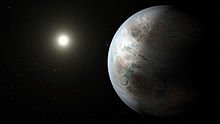Kepler-452b (a planet sometimes quoted to be an Earth 2.0 or Earth's Cousin[3][4] based on its characteristics; also known by its Kepler Object of Interest designation KOI-7016.01) is a super-Earth exoplanet orbiting within the inner edge of the habitable zone of the sunlike star Kepler-452 and is the only planet in the system discovered by Kepler. It is located about 1,800 light-years (550 pc)[5] from Earth in the constellation of Cygnus.
Kepler-452b
Kepler-452b artist concept.jpg
Artist's impression of Kepler-452b (center), depicted here as a rocky planet in the habitable zone with extensive cloud cover. The actual appearance of the exoplanet is unknown.

Discovery
Discovered by : kepler science team
Discovery site : kepler
Discovery date : 23 july 2015 (announced)
Detection method : Transit
Designation
Alternative names : KOI-7016.01
Orbital characteristics
Semi-major axis : 1.046+0.019−0.015[1] AU
Orbital period (sidereal) : 384.843+0.00−0.012[1] d
Inclination : 89.806+0.134−0.049
Star : Kepler-452
Physical characteristics
Mean radius : 1.5+0.32−0.22[1] REarth
Mass : 5 ± 2[2] MEarth
Surface gravity : 1.9+1.5
−1.0 (est.) g
Temperature : Teq: 265 K (−8 °C; 17 °F)[1]
Kepler-452b circles its star a ways off of 1.04 AU (156 million km; 97 million mi) from its host star (almost a similar distance as Earth from the Sun), with an orbital time of about 384 days, has a mass something like multiple times that of Earth, and has a sweep of around 1.5 times that of Earth. It is the principal possibly rough super-Earth[5] planet found circling inside the tenable zone of a very sunlike star.[6] However, it is obscure assuming it is no doubt tenable, as it is getting somewhat more energy than Earth and could be exposed to an out of control nursery impact.
The Kepler space telescope identified the exoplanet, and its discovery was announced by NASA on 23 July 2015.[7] The planet is about 1,800 light-years (550 pc) away from the Solar System. At the speed of the New Horizons spacecraft, at about 59,000 km/h (16,000 m/s; 37,000 mph), it would take approximately 30 million years to get there.[8]